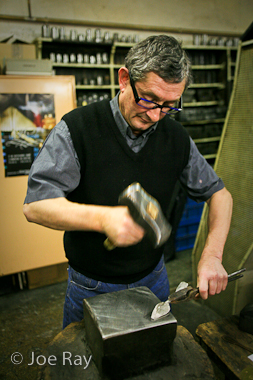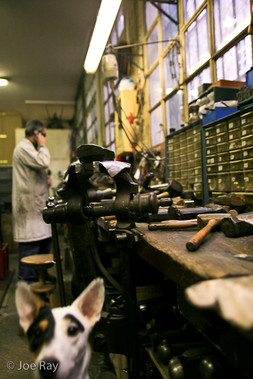Silversmiths in Paris - Cutting Edge Tradition
October, 2008 - Platinum Magazine

PARIS: on a side street at the top of the Marais neighbourhood, lost among wholesale shop fronts and residential apartments, there is an unassuming door. Enter and follow the maze of passageways and courtyards back to the end and you’ll find the last hand-forged silverware maker in the City of Light.
“Isn’t there someone out in the suburbs who still does it by hand?†silversmith Jean-Pierre Cottet calls back to his boss, Francis Regala.
“Don’t think so,†comes the response. “Didn’t that guy die?â€
The Rue des Gravilliers is the historic home of Paris’ orfèvres – silversmiths – and while the other ‘white blouses’ have left the street and given way to more modern practices and changing tastes, the three-person Orfèvrerie Richard is still going strong.“It was our little project. Francis had worked [as a silversmith] with his father who had done the same thing,†says Danielle Regala, describing how she and her husband moved from Provence to Paris in 1994, buying the shop and its name from its previous owner. “We are one of the last to do everything by hand. That’s our little plus,†she says, borrowing the last word from English.
“I started doing this when I was 16,†says Francis, as he shines up a few pieces on a buffing machine. “I’m 58 – so that’s 42 years.â€
While larger French competitors like Odiot and Puiforcat have a technique that’s more modern than Richard’s hammer forging, you will likely find their goods in high-end boutiques in a more up-market section of the city, and pay twice as much.
“We’re hidden in a courtyard,†says Danielle, who is the face of this tiny operation, “It’s like a confidential showroom.
The tiny display room, filled with display cases of products, feels crowded with more than two people, but in the back, Messrs Regala and Cottet have room to roam or swing their mallets. There are individual and shared workbenches, shelves of silverware dies that, here, serve as more than trendy bookends and scores of specialised tools, all centred around a giant press, flanked on either side with huge flywheels.
The walls are covered with scores of mallets and hundreds of tiny cubbyholes filled with fittings, clippers, and tiny nuts and bolts, probably not too dissimilar to a silversmith‘s shop a century ago.
“It’s a rare trade. It started disappearing in the 1950s,†says 27- year-old Cottet. “But now people are coming back to it. We’re learning to present things again.â€
 Spoons on the workbench at Orfevrerie Richard in Paris. Photo by Joe Ray
Spoons on the workbench at Orfevrerie Richard in Paris. Photo by Joe RayKnown as orfèvre cuilléristes (Danielle likes to simply call what they do l’art de la table) they repair silver as well as create new items. They serve antique dealers, museums and individuals, and offer near-impossible-to-find services on an incredibly personal scale. Regular customers often go directly into the workshop and chew the fat with Francis before placing an order.
Though they never divulge clients’ names, they do share some of their more interesting projects. Cottet places a special silver and gold fork made for a Russian client in my hand, and I immediately note its comforting heft. I place it on the tiny scale next to the cash register: 102 grammes.
Along with their classic designs and silverware, there’s also what they call the Cinderella Teapot – a beautiful and incredibly detailed one-off which they did as a trade show piece. With rough-cut precious stones and stubby little wooden feet that make it look like it might shuffle away at any moment, it’s lighthearted, but also a testament to the beauty and intricacy of the work they can do.
With items like these, the Marais shop turns out to be the perfect place to let your mind wander. I imagine an exquisite last meal à la François Mitterand, centered around a man with his golden silverware set, old, lonely yet dignified. The phone rings and I wander over and pick up some silverware-sized ingots that are the raw blocks the finished pieces begin with. They are still warm to the touch. Fifteen minutes earlier, they would have roasted my hand – the first step in the silverware-making process is heating these with a flame-thrower until they turn a molten red colour.
 “It’s a rare trade. It started disappearing in the 1950s,†says Jean-Pierre Cottet. “But now people are coming back to it. We’re learning to present things again.†Photo by Joe Ray
“It’s a rare trade. It started disappearing in the 1950s,†says Jean-Pierre Cottet. “But now people are coming back to it. We’re learning to present things again.†Photo by Joe Ray
Cottet’s insistent hammering in the main room takes me out of my reverie and he shows me part of the production process. He places a fork over a convex mould and begins tapping away at the tines.
“When you work silver,†he explains, still tapping, “hitting it makes it harder.â€
I take pictures as he hammers, but as I watch through the lens, the fork jiggles with each stroke, but it doesn’t look like much is happening.
“This must take forever,“ I venture, but it turns out he was just posing for photos. He smiles and switches hammers, this time picking up a short-handled cousin of a sledgehammer to do it for real. With full swings that make satisfying Bam! Bam! Bam! noises, the fork quickly bends to his will.
“It’s physical,†Cottet adds with a smirk. “We end up with one arm bigger than the other.â€
I ask Francis if he’s thinking of retiring and he pauses and squints like he‘s trying to see into a too-distant future and says, “I’ll stop slowly.â€
Another pause. Another squint, and then, “If there’s interesting stuff to do, I won’t stop.â€
http://www.orfevrerie-richard.com
Joe Ray
See the .pdf version of this story as it ran in American Express Platinum Magazine here